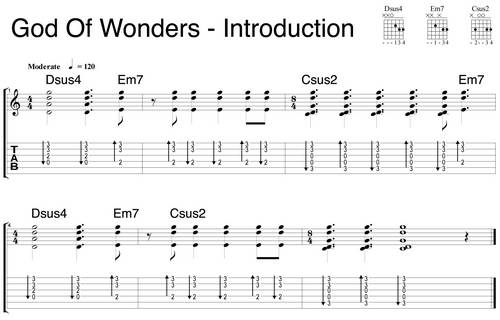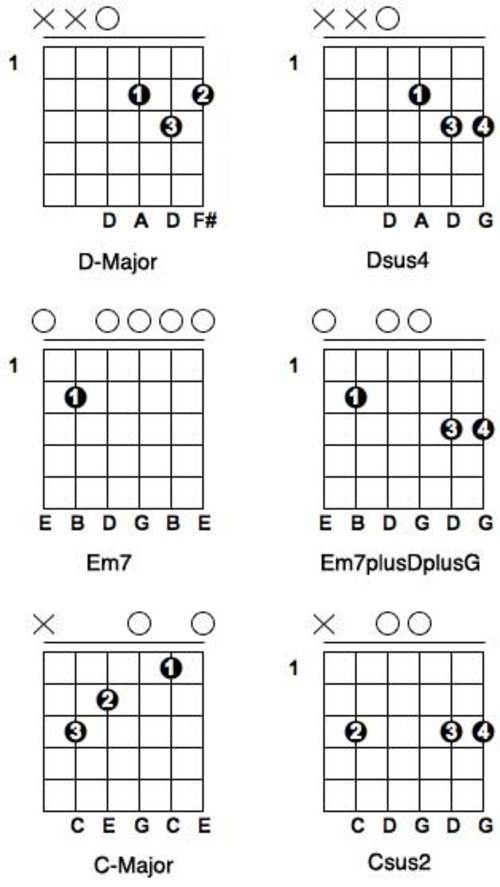God Of Wonders For Guitar
If you attend a Christian church, you'll probably recognize the popular praise and worship tune God of Wonders. Written by Steve Hindalong and Marc Byrd. It's a great song to learn. It's not too difficult, has interesting rhythm patterns, and it exposes the beginner to some useful chord variations.
By the way... Start-Playing-Guitar.Com is all about learning to play the guitar. One way to accomplish this is to explain how to play songs that most people are familiar with. My intent is to help you play guitar, not to reproduce copyright materials. The simplified versions here are my own work, intended for private study and self-education while taking ease of play into account. If you want a copy of the as-recorded sheet music, you can get it here: God Of Wonders For Piano with Guitar Chords
.
Chords And Key
God of Wonders is typically played in the key of G, using the chords: G, C, D, Am, and Em, or variations. Because of the variations, which I'll explain section by section below, the chords are sometimes shown with names you might not recognize. Don't let the complex-looking chord names scare you off, the variations actually make playing the song easier.
It's not unusual for Christian artists to place their little finger and ring finger on the third fret of the first and second strings when playing in the key of G. Doing so introduces the notes G and D into chords that normally do not have them. In God of Wonders, this is done during the introduction and verses with the G, Em7 and C chords.
Playing The Intro And Verse
The eight-bar introduction of God of Wonders uses the same strumming pattern and chord progression as each verse. Learn the intro, and you already know about two-thirds of the song. Here's what the music notation looks like for the introduction:
 |
Easily Playing the Dsus4, Em7, Csus2 Chords
Because you leave your little finger and ring finger in place, the chords used in this song are easier to play than if you played the open chords normally. Instead of moving all fingers, you move only one or two.
The chord chart below shows the standard open D, Em7, and C chords on the left, and the variation used in this song on the right. To play the introduction, you begin with the Dsus4 chord, then move to the Em7 (plus D, plus G) chord. Notice that you move only one finger to play the second chord!
Moving from the second chord (Em7) to the third (Csus2) is a simple matter of placing another finger down on the adjacent fret. The final (and optional) chord of the intro and verse is a simple matter of lifting this finger.
Note: I sometimes prefer to play a normal C-Major chord, as I think it provides a full, rich, sound.
 |
The Rhythm Pattern For The Intro and Verse
If you can read the music notation, above, you can figure out the strumming pattern. If you're not certain how to play it, don't worry, I've included two videos to help you learn the pattern. The first is a slow-temp version of the chord progression and strumming pattern. The second is closer to full speed for God of Wonders.
Watch the first video, paying particular attention to the alternating downstrokes and upstrokes. My strumming hand moves more than the actual strumming. Doing so allows you to keep the right tempo. Just because our hand moves past the strings doesn't mean you have to strum them. After a few plays, try strumming along.
Once you have the strumming pattern down, play the second video, which is much closer to performance speed. If you're uncertain of the chord patterns I've included a third video, below, that plays the intro and verse patterns plus the chorus, with a close-up of the chord-hand.
Video: The Intro and Verse At Slow Speed
Remember that you'll use both up and down strumming to play this pattern (see the up/down arrows in the music notation, above). Also notice that my strumming arm does not stop. When you keep your arm moving to the beat, your strumming is nice and regular. Play the video several times (it's only 19 seconds) to see exactly what I'm doing, then try it yourself. Take it slow at first, you'll be able to speed up with a little practice.
Video: The Intro and Verse At Near Performance Speed
Ready to pick up the pace? Play this video, which again plays the introduction and verse chord progression and strumming pattern of God of Wonders. See if you can play along for the entire 29 seconds. Try to keep a steady beat. See if you can play the Csus2 to Em7 walk-down before heading back to the Dsus4. Try a normal C chord and see if you like it. Enjoy!
Playing The Rest Of The Song
Once you get through the very recognizable introduction and verse, you reach the chorus. Here, you can be creative with your strumming pattern. I have one that I like, which you'll here in my third God of Wonders video. Some like to play the same pattern as the intro. Try both, or make up your own.
To play the chorus you also need to know the roadmap to follow. For that, you need the words. Here they are:
Intro:
Dsus4 Em7 Csus2 (optional walkdown to Em7)
Dsus4 Em7 Csus2 (optional walkdown to Em7)
Verse 1:
Dsus4 Em7 Csus2 (optional walkdown to Em7)
Lord of all creation,
Dsus4 Em7 Csus2 (optional walkdown)
Of water, earth and sky.
Dsus4 Em7 Csus2 (optional walkdown)
The heavens are Your tabernacle,
Dsus4 Em7 Csus2 (start a steady beat)
Glory to the Lord on high!
Chorus:
G D
God of wonders, beyond our galaxy
Am C
You are holy, holy
G D
The universe declares Your majesty
Am C
You are holy, holy
C D (shifted C) C
Lord of heaven and earth
C D (shifted C) C
Lord of heaven and earth
Verse 2:
Early in the morning
I will celebrate the light
And as I stumble through the darkness
I will call Your name by night
Repeat Chorus
Song Continues, Varied by Artist,
Search the Internet for your favorite.
Video: Close Up On Playing All The Chords
If you have any questions on how to play the chords, or what is meant by the "(shifted C)" note above, take a look at this video. In it, I play the intro/verse chord progression several times, play once through the chorus, then return to the verse chord progression. In a short 1:16 any remaining questions should be answered.
Additional How-To Videos
These two excellent videos each show how to play the song.
The first takes it slow, and offers another explanation of the strumming patterns. It's good if you've never heard the song, and want to hear a slowed up version.
The second video is an interview with Steve Hindalong and Marc Byrd, the two men who wrote the music and lyrics. It gives information on their recording, more on how to play the chords, and how to play the lead-guitar riff in the middle of their recording.
As always, Enjoy!


